![]()
On Thursday afternoon, the Professional Hockey Writers’ Association announced its mid-season award winners.
More than 125 writers representing all 31 chapters completed ballots for the 10 awards, which not only included traditional staples like the Hart, Norris and Calder Trophies, but also included two non-traditional awards: The Rod Langway Award for best ‘defensive defenseman,’ and Comeback Player of the Year, given to a player who has returned to a previous high level of performance that was interrupted by sub-par play, long-term injury or major illness.
Generally, there weren’t many surprises.
Nikita Kucherov, Johnny Gaudreau and Connor McDavid were the top three vote-getters for the Hart Trophy, given to the most valuable player, Elias Pettersson received the most votes for the Calder Trophy, awarded to the league’s top rookie, and Barry Trotz, who has completely turned around the New York Islanders despite the team losing captain John Tavares to free agency, topped the list for the Jack Adams Trophy, given to the coach adjudged to have contributed the most to his team’s success.
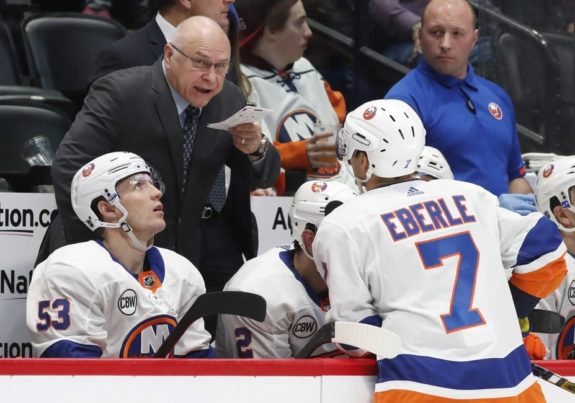
There were some omissions, however, starting with the Norris Trophy.
Penguins’ Letang Deserves Recognition as a Top D-Man
Like the Hart, the Norris Trophy is often debated because of the definition of the award. Technically, the award is given to the defenseman who demonstrates “the greatest all-around ability in the position,” but it often goes to the defenseman who is most proficient offensively. Seven of the last nine Norris winners finished in the top-two in scoring among defensemen that season.
This is why the PHWA came up with the Rod Langway Award, to recognize defensive accomplishment.
Because the Norris cites “all-around ability,” I believe it shouldn’t go to a player whose team gives up lots of chances when they are on the ice or to a player who mostly plays in offensive situations. I don’t agree with Morgan Rielly receiving the second-most votes and Brent Burns receiving the third-most votes (Mark Giordano in the top spot is perfect).
According to Bill Comeau’s SKATR comparison tool, Rielly is on the ice for 56.6 shot attempts against per-60 minutes (CA/60), putting him in the sixth percentile in the league. His expected goals against per-60 minutes (xGA/60) of 2.78 is in the fifth percentile in the league. That’s not bad, that’s horrendous.
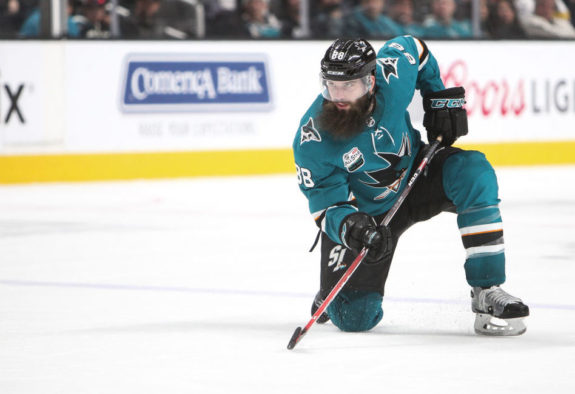
Burns, meanwhile, is in the fourth percentile in the NHL in zone start ratio (ZSR) and is in the 41st percentile for quality of competition (QoC). His 62.63 ZSR is the fifth-highest among defensemen. I can’t get on board with giving the award for the best defenseman to someone who is barely ever used in defensive situations (112th in shorthanded ice-time per game as well) and so rarely plays against the league’s best players.
Don’t get me wrong, Rielly has been phenomenal offensively this season, ranking third among defensemen in points (50) and first in points per-60 minutes (P/60) at 2.01 (there is also the argument that playing with Ron Hainsey is the reason for all of those chances against). Burns has done much of the same offensively, ranking first in points (55) and third with 1.76 P/60.
But why is Kris Letang getting no love when he has been exemplary at both ends of the ice? He is sixth in the NHL among defensemen in points (40), 10th in P/60 (1.43), first in Corsi for percentage relative to his teammates (RelCF%) at 7.56 and has the second-best goal differential at five-on-five, at plus-21 (seventh-best goals for percentage among defensemen at 62.35).
He plays against top competition every night (96th percentile), doesn’t only start in the offensive zone (55th percentile), and has a Corsi Against per-60 in the 62nd percentile (compared to Rielly’s Corsi Against per-60 in the sixth percentile).
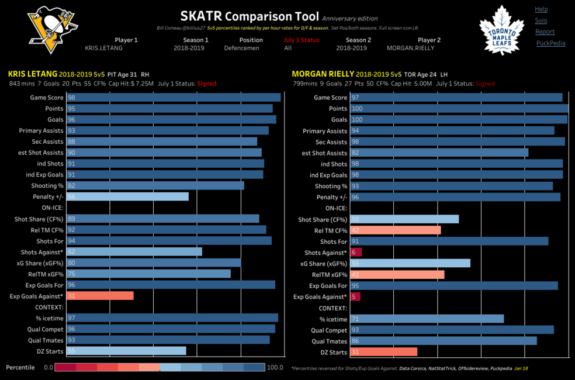
As the chart above shows, Letang has been almost as good as Rielly offensively and much better defensively. I’d be interested to see if Letang cracked the top-five on the ballot because I have a feeling that he was also beat out by players like Erik Karlsson and John Carlson, which shouldn’t be the case. Instead, I’d have voted Giordano for top spot, then Letang and then Rielly.
Lehner and Vasilevskiy Absent From Vezina
I’m going to assume both Robin Lehner and Andrei Vasilevskiy were absent because of a lack of playing time.
Vasilevskiy has started in just 28 games for the Tampa Bay Lightning (20th in the NHL), while Islanders’ netminder Lehner has only started 25 games this season (tied for 23rd). The top-three vote-getters — John Gibson, Marc-Andre Fleury and Frederik Andersen have each started in 34 or more games.
Whether that’s the reason or not, it’s wrong to leave off the top-two goalies in the league in save percentage (SV%, minimum 20 games played). Lehner’s turn around has been one of the best stories in the NHL this season, and he deserved to receive the most votes for Comeback Player of the Year. I’m not sure how his 15-7-4 record, 2.02 goals-against average (GAA) and .931 SV% so far this season weren’t enough for Vezina consideration. His save percentage and goals-against average are both the best in the league.
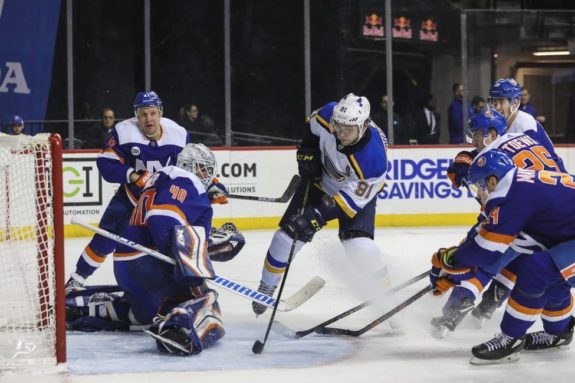
Another telling stat is goals saved above average (GSAA). It measures a netminder’s play against that of a league-average keeper and takes into account shot quality. In all situations, Lehner’s 17.6 GSAA is first in the NHL. The same can be said for Vasilevskiy, who is second in the league in save percentage (.925) and whose 20-6-2 record gives him the best win percentage at .714. His 15.43 GSAA in all situations is third-best in the NHL.
I would have gone with both Lehner and Vasilevskiy instead of Fleury and Andersen. Gibson still deserves to be there given the heavy workload he’s had to carry on an Anaheim Ducks team that gives up the third-most shots in the league per game. Somehow, Gibson has a .919 SV% (tied for 7th) and his 17.44 GSAA is second-best.
Dumoulin or Spurgeon for Rod Langway Award
I really like the idea of handing out an award for the best defensive defenseman and think the league should implement it.
In order for us to try to determine who “best excels in the defensive aspect of the game,” there are some requirements. First, you need to play a lot. Second, you need to play in defensive situations and against the opposition’s top players. Third, you need to have a positive impact when you’re on the ice.
I’ve narrowed down a list of the league’s blueliners that meet the following criteria: First, at least 600 minutes played; second, at least two minutes of shorthanded ice-time per game; third, a zone-start ratio (ZSR) below 52 percent; fourth, Corsi for and goals for percentages above 50, as well as a positive relative Corsi for percentage; and finally, quality of competition (QoC) in at least the 70th percentile. I’ve also included the three top vote-getters, even if they fail to meet the criteria (in order, they were Mattias Ekholm, Mark Giordano and Victor Hedman).
| Player | CF% | Rel CF% | GF% | QoC (Percentile) | ZSR | Shots Blocked | Giveaways | Minor Penalties Taken | SH TOI/Game |
| Mattias Ekholm | 52.66 | 1.22 | 60.27 | 73 | 49.21 | 52 | 33 | 11 | 02:11 |
| Mark Giordano | 55.93 | 4.53 | 60.56 | 100 | 51.71 | 59 | 30 | 13 | 02:47 |
| Victor Hedman | 53.61 | 3.13 | 54.29 | 48 | 51.83 | 49 | 23 | 11 | 01:54 |
| Jared Spurgeon | 52 | 2.46 | 53.95 | 96 | 51.05 | 58 | 9 | 4 | 02:28 |
| Kris Letang | 53.62 | 7.56 | 62.35 | 96 | 49.29 | 64 | 33 | 7 | 02:05 |
| Brian Dumoulin | 53.61 | 6.86 | 60.92 | 91 | 47.78 | 62 | 25 | 6 | 02:13 |
| Ryan Murray | 50.66 | 1.11 | 54.76 | 77 | 48.53 | 50 | 19 | 2 | 02:39 |
First thing’s first: Hedman should not be in the running. His QoC is in the 48th percentile, which tells me he doesn’t always get the tough assignments in Tampa. The addition of Ryan McDonagh has allowed head coach Jon Cooper to ease Hedman’s workload.
Yes, Ekholm and Giordano deserve to be considered, but so do others, namely Jared Spurgeon and Brian Dumoulin.
The reason I went with a ZSR below 52 and not 50 is that Spurgeon needs to be on this list. He checks off all of the aforementioned requirements except his ZSR was just a smidgen above 50. For someone who plays against top competition as much as he does, to only have recorded nine giveaways and taken four minor penalties is also remarkable.
Dumoulin jumps out as well. Playing with Letang surely helps (he also cracks the list), but everything about Dumoulin’s game from a defensive aspect is likeable. Just look at all the blue!
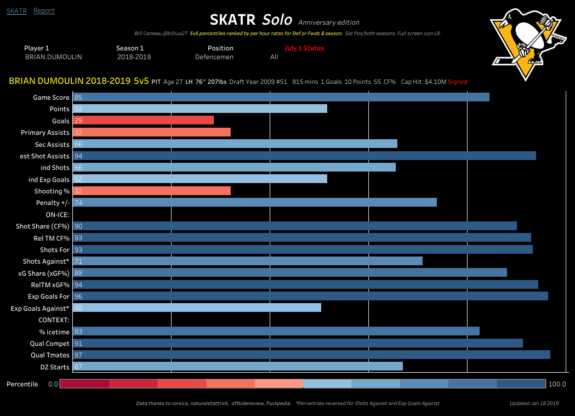
I should also point out that many defensemen almost made the list. Players like Jonas Brodin, Aaron Ekblad, Niklas Hjalmarsson and Adam Larsson all had positive relative Corsi for percentages, a Corsi for percentage over 50 and faced tough competition while playing over 600 minutes, but their poor goals for percentage took them out of the running.
Anybody not voting Hjalmarsson for the Langway: what is wrong with you. This is with heavy defensive zone usage. pic.twitter.com/D0js5EQbRK
— Micah Blake McCurdy (@IneffectiveMath) January 24, 2019
This award is a tough one to determine, which is why it doesn’t actually exist. It’s not that tough, however, to determine that Hedman shouldn’t be a top-three selection on the ballot. There are plenty of more deserving players.
All in all, the PHWA selections at the halfway point of the season were nearly spot on. The Vezina omissions of Lehner and Vasilevskiy were the only obvious ones, while some of the defensive award nominees were certainly questionable. With just over 10 weeks until the regular season is up, it’ll be interesting to see if those on top can hold on to their lead, or if those trailing can rise up the ranks.